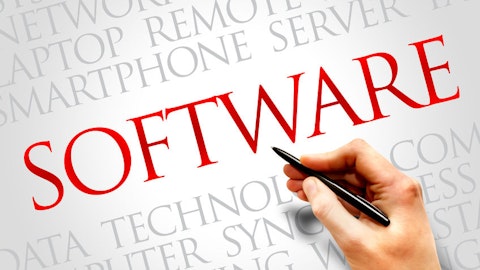Fatima Boolani: I appreciate that Yogesh. And Anthony, can you — on the net retention rate at 99%, now just a nitpick that is shy [ph] below your internal threshold at 100%. So, any nuances you can offer to us on why that step down? You’ve been pretty consistently at 100, 100-ish level, 100%-ish. So, just wanted to get maybe some additional context around that slight compression this quarter? Thank you.
Anthony Folger: Yes. Sure Fatima. The — I would say the compression because we measure our net retention rates on a trailing 12-month basis, you sort of have to look back over that trailing 12-month period and figure out the ins and outs. And we mentioned in Q4 that we had a couple of contracts churn out. One of them was due to M&A, frankly, where we ended up losing a customer. And that impacted us in Q4, brought the net retention rate down a little bit. And that contract is still in the denominator of our calculation. It will be there for a couple more quarters. So, we’re not surprised to see things at 100% or 99% for a little bit, certainly doesn’t change our long-term outlook from a net retention and a target perspective of being 100% or better.
Fatima Boolani: Thank you.
Anthony Folger: Yes.
Operator: Thank you. One moment for our next question and that will come from the line of Brent Thill with Jefferies. Your line is open.
Antonio Venturim: Hi guys. Thanks for taking the question. This is Antonio Venturim for Brent Thill. It looks like you guys had an overall strong quarter on the top and bottom-line. Can you just give us your puts and takes on the delta between ARR growth sort of being flat to slightly up versus revenue growth growing in the double-digits? If you could just give us puts and takes on that, that would be great.
Anthony Folger: Yes, sure. Sure, Antonio. I can take that. So, for the quarter, MarkLogic if you sort of take a look at the year-over-year, we only got a month contribution from MarkLogic last year, and we get a full quarter this year. So, that drove the vast majority of our growth. But there was an offset to that, right? We did have some multiyear subscription contracts that executed last year. They renewed last year. We didn’t have the same opportunity this year in the quarter. So, when you’re looking at revenue on a year-over-year basis, I think the right way to reconcile it is you’ve got some growth from MarkLogic, it gets offset a little bit by the timing of contract renewals, some of those subscription deals. And so you can still sort of reconcile down to low single-digit growth on the revenue, but ARR just ends up being, I think, a more accurate reflection this quarter of what’s going on in the business fundamentally.
Yogesh Gupta: And what’s interesting is that when you look at ARR year-over-year, last year, the pro forma ARR of MarkLogic was included in last year’s results. So, when you think about it that way, right, when we compare ARR, we include acquisition prior ARR as though it was part of our business. So, the growth in ARR is really sort of the real growth of the business or the real trajectory of the business, whereas until you have a full 12-month cycle, the actual reported revenue looks significantly higher because MarkLogic is adding to this quarter for a full quarter, whereas last year, as Anthony said, was just about a month.
Antonio Venturim: Thanks for taking the question and congrats on the quarter.
Yogesh Gupta: Thanks.
Operator: Thank you. [Operator Instructions] One moment for our next question and that will come from the line of Pinjalim Bora with JPMorgan. Your line is open.
Pinjalim Bora: Great. Thanks for taking the questions. I want to ask you on MarkLogic, I heard throughout the word RAG along with MarkLogic, — it’s — I know it’s a document database, but can you remind us what has MarkLogic developed so far from a RAG standpoint? Have they created a Vector DB store? Is there a search layer in there? Maybe help us understand that — are you seeing customers look at that more seriously as — for their RAG use cases?
Yogesh Gupta: Great question, Pinjalim. So, what we have done — so if you think about MarkLogic, of course, is really unstructured data. But Semaphore on top of that, right, is the semantic analysis of that information. And so the question becomes when you get information out of an LLM, how do you contextualize it? So, yes, we have actually created capabilities, and we have — I don’t want to say customers in production, but we have customers who are looking to figure out how to use it to actually leverage their content and their data using both MarkLogic and Semaphore on top of their information and then augmenting any receivable that they do through LLMs of any generative content, right? So, you get — the LLM will do its thing. Basically, they augment the generation with information from MarkLogic/Semaphore and therefore, provide more contextual answers. I wish we get to the point where we have production customers, we can talk about it.
Pinjalim Bora: Interesting. Yes, thank you for that Yogesh. One for Anthony. I hear you on the comment that you made about kind of the customer churn — you had a couple of customers churn last quarter, and that’s kind of impacting NRR. But when I see the sequential decline in ARR seems like it’s a little bit more than maybe a year ago or even maybe last quarter. Just want to make sure that there is no incremental gross dollar churn that you’re seeing at this point? Thank you.




